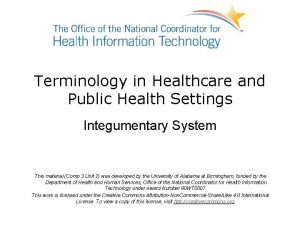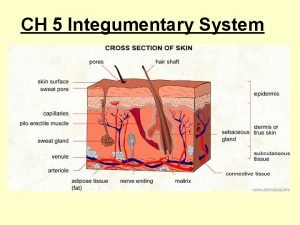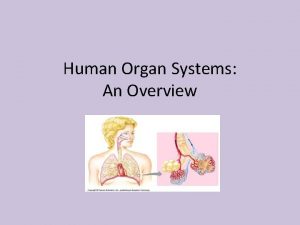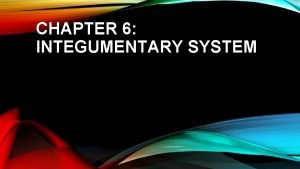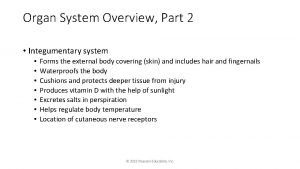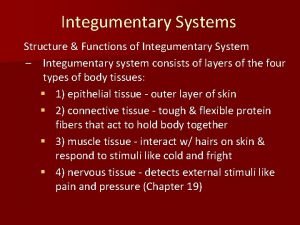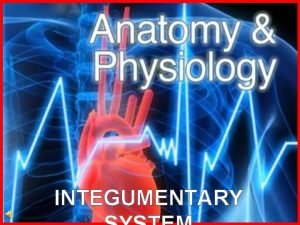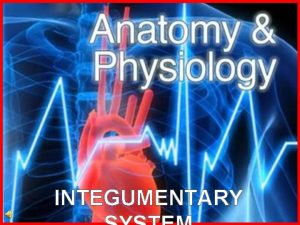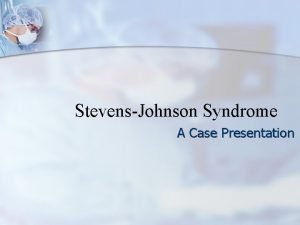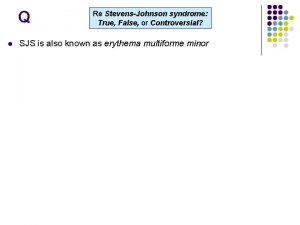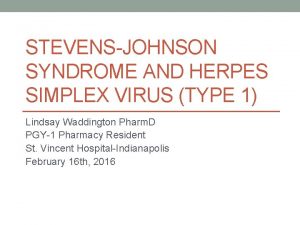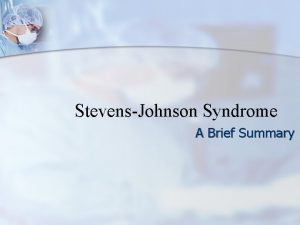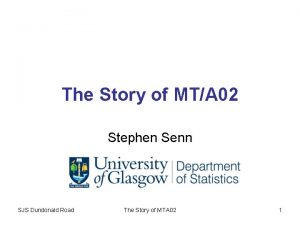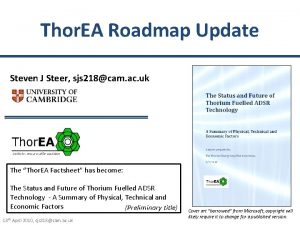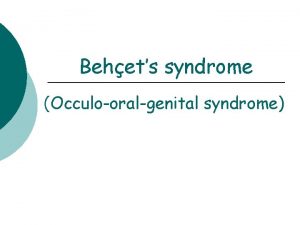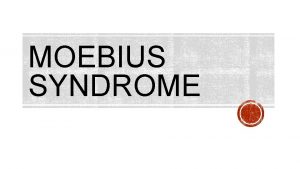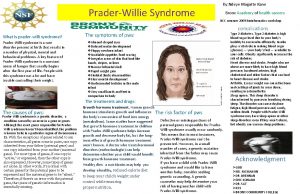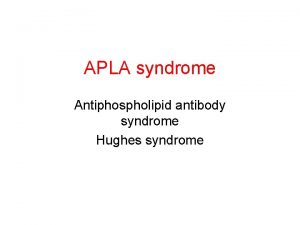Integumentary StevensJohnson Syndrome SJS What is it a



















- Slides: 19

Integumentary Stevens-Johnson Syndrome SJS

What is it • a rare, serious disorder of the skin and mucous membranes • In adults its usually caused by a drug reaction • In children its usually caused by an infection • Lesions cover <10% • Mortality rate 5%

Pathophysiology • Theory: altered drug metabolism (eg, failure to clear reactive metabolites) in some patients triggers a T-cell– mediated cytotoxic reaction to drug antigens in keratinocytes – CD 8+ T cells have been identified as important mediators of blister formation

Pathophysiology • Theory: granulysin released from cytotoxic T cells and natural killer cells might play a role in keratinocyte death – Granulysin concentration in blister fluid correlates with severity of disease

Pathophysiology • Theory: interactions between Fas (a cell -surface receptor that induces apoptosis) and its ligand, particularly a soluble form of Fas ligand released from mononuclear cells, lead to cell death and blister formation

Toxic epidermal necrolysis TEN • • Severe form of SJS Cell-mediated cytotoxic reaction Lesions cover >30% of body Mortality rate is 40%

Clinical Manifestations • Within 1 to 3 wk after the start of the offending drug, patients develop a prodrome of malaise, fever, headache, cough, and keratoconjunctivitis • Macules, often in a target configuration, then appear suddenly, usually on the face, neck, and upper trunk

Clinical Manifestations • Macules simultaneously appear elsewhere on the body, coalesce into large flaccid bullae, and slough over a period of 1 to 3 days • Nails and eyebrows may be lost along with epithelium • The palms and soles may be involved

Clinical Manifestations • Skin, mucosal, and eye pain are common • In some cases, diffuse erythema is the first skin abnormality of toxic epidermal necrolysis

Clinical Manifestations • Skin is excruciatingly tender • Loss of skin leaves a weeping surface similar to a total-body, partial thickness burn

Severe TEN • large sheets of epithelium slide off the entire body at pressure points exposing weepy, painful, and erythematous skin • Painful oral crusts and erosions, keratoconjunctivitis, and genital problems accompany skin sloughing in up to 90% of cases

Severe TEN • Bronchial epithelium may also slough, causing cough, dyspnea, pneumonia, pulmonary edema, and hypoxemia • Glomerulonephritis and hepatitis may develop


Medical Management • Ophthalmology consultation and specialized eye care mandatory for patients with ocular involvement • Potentially causative drugs should be stopped immediately • Patients are isolated to minimize exposure to infection

Medical Management • Fluids, electrolytes, blood products, and nutritional supplements as needed • Skin care includes prompt treatment of secondary bacterial infections and daily wound care as for severe burns • Prophylactic systemic antibiotics are controversial and often avoided

Nursing Interventions • Skin assessment – Monitor for infection – Monitor for development of new blisters – Monitor the amount and characteristics of blister drainage • Oral assessment – Blistering and erosive lesions – Ability to swallow and drink fluids – Ability to speak normally

Nursing Interventions • Assess for itching, burning, and dryness of the eyes – Monitor for conjunctival hemorrhage • Vital signs • Respiratory assessment

Watch for • High fever, tachycardia, and extreme weakness and fatigue may indicate the process of epidermal necrosis, and GI and respiratory mucosal sloughing • Daily assessment of puncture sites and IV sites for oozing • Careful assessment of GU system • Daily weights

Nursing Diagnoses • Impaired tissue integrity r/t epidermal shedding • Fluid volume deficit • Electrolyte imbalance • Impaired thermoregulation • Acute pain • Anxiety • Impaired mobility • Nutrition less than body requirements
 Sjs
Sjs Sjs golf balls
Sjs golf balls Integumentary system cpt coding guidelines ppt
Integumentary system cpt coding guidelines ppt Intugementary
Intugementary How do you pronounce integumentary
How do you pronounce integumentary Integumentary system
Integumentary system Cat integumentary system
Cat integumentary system Integumentary system adalah
Integumentary system adalah Integumentary system
Integumentary system Cells in stratum spinosum
Cells in stratum spinosum Section 36-3 the integumentary system
Section 36-3 the integumentary system Integumentary system medical terminology
Integumentary system medical terminology Chapter 6 integumentary system
Chapter 6 integumentary system Glands in integumentary system
Glands in integumentary system Duct of merocrine sweat gland
Duct of merocrine sweat gland Integumentary system
Integumentary system Integumentary system physical examination
Integumentary system physical examination The integumentary system
The integumentary system Epidermis layers
Epidermis layers Excretory and integumentary system
Excretory and integumentary system




